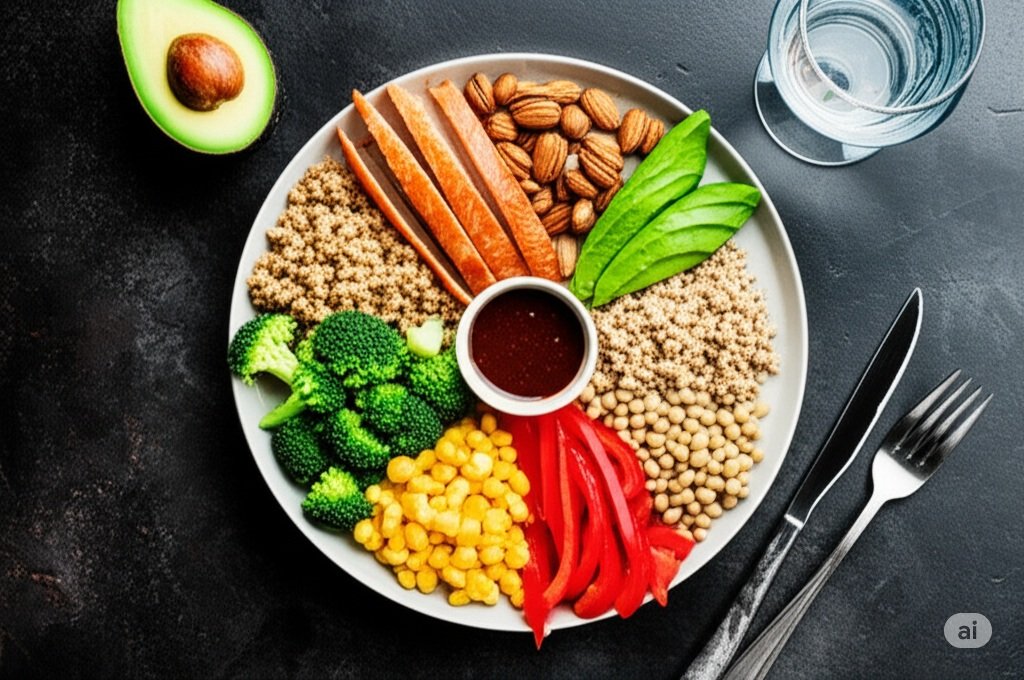The Simple Guide to Building a Balanced Plate


Creating healthy and satisfying meals doesn’t have to be complicated. The key lies in understanding the basics of building a balanced plate. This simple approach to nutrition ensures you’re getting the right mix of nutrients to fuel your body and support overall well-being. Let’s dive into how you can easily create balanced meals for yourself and your family.
The Power of Portioning
One of the fundamental aspects of a balanced plate is portion control. While the exact amounts will vary depending on your individual needs (age, activity level, etc.), a visual guide can be incredibly helpful. Imagine your plate divided into sections.
- Half of your plate: Should be filled with non-starchy vegetables. Think colorful options like broccoli, carrots, bell peppers, spinach, and salad greens. These are packed with vitamins, minerals, and fiber, which are essential for good health.
- One quarter of your plate: Should be dedicated to lean protein sources. This includes chicken breast, fish, turkey, beans, lentils, tofu, and lean cuts of beef or pork. Protein is crucial for building and repairing tissues, and it helps you feel full and satisfied.
- The remaining quarter of your plate: Should consist of whole grains or starchy vegetables. Opt for brown rice, quinoa, whole-wheat pasta, sweet potatoes, or corn. These provide energy and also contribute fiber and important nutrients.
Don’t Forget the Extras
While the plate itself is the main focus, there are a few other components to consider for a truly balanced meal:
- Healthy Fats: Incorporate sources of healthy fats like avocados, nuts, seeds, and olive oil. These are important for heart health and nutrient absorption. Use them in moderation as part of your meal.
- Fruits: While not directly on the main plate, aim to include a serving of fruit as part of your meal or as a healthy snack. Fruits are rich in vitamins, minerals, and antioxidants.
- Hydration: Drink plenty of water throughout the day. Water is essential for countless bodily functions.
Making it a Habit
Building a balanced plate is a skill that gets easier with practice. Here are a few tips to help you make it a habit:
- Plan your meals: Thinking ahead can make it easier to ensure you have the right ingredients on hand.
- Prep ahead: Washing and chopping vegetables or cooking grains in advance can save you time during busy weeknights.
- Get creative: Experiment with different recipes and ingredients to keep your meals interesting and enjoyable.
- Listen to your body: Pay attention to your hunger and fullness cues. Balanced meals should leave you feeling satisfied but not overly full.
By following these simple guidelines, you can easily build balanced plates that provide your body with the nutrients it needs to thrive. It’s a sustainable and effective approach to healthy eating that everyone can adopt!
Recent Posts
Apple’s Big Plans for Early 2026: What to Expect
Get ready, tech enthusiasts! Apple is reportedly gearing up for a significant wave of product… Read More
Understanding Trump’s Latest Move Against Canada and Beyond
A Bold Stance on Trade Relations The global trade landscape is once again shifting as… Read More
Stop Believing These Common Weight Loss Myths
Tired of weight loss advice that just doesn't work? Debunking the most common myths about… Read More
Sweat Smarter, Not Harder: Your Beginner’s Guide to Home Workouts
Ready to get fit without leaving your house? This beginner-friendly guide covers everything you need… Read More
Did False Data Cost Columbia $9 Million? What the Lawsuit Means for Students
Columbia University settles a $9 million lawsuit over alleged false data in college rankings. Discover… Read More
US Stock Market Why Futures Dipped After Record Highs
US stock futures dip after record highs. Explore what's driving this pullback, from federal policy… Read More